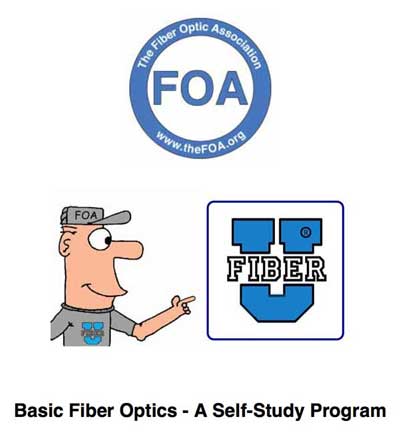Lesson 2, Fiber Optic Jargon
FOA Reference Guide To Fiber Optics
And Study Guide To FOA Certification

Answers To Chapter Questions
Chapter 2 Quiz-Jargon
TRUE/FALSE
1. ANS: T
Telecom or LAN signals are digital, but most CATV and CCTV signals are analog.
2. ANS: T
The core of a singlemode fiber is 8-9 microns in diameter, while multimode fiber cores are 50 or 62.5 microns.
MULTIPLE CHOICE
3. ANS: A
Light
travels in the core, where it is trapped by the cladding. The buffer is
a plastic protective coating for the fiber and the jacket is the
outside layer of a cable.
4. ANS: C
Multimode fiber, for example, is either 50 or 62.5 micron core diameter and 125 micron cladding diameter.
5. ANS: D
Multimode fibers have many modes or rays of light, while singlemode fiber only carries one mode.
6. ANS: A
dB is a relative measurement used for loss. dBm is absolute power referenced to 1 milliwatt.
7. ANS: B
dB is a logarithmic function, dB = 10 log (power ratio), so 10 dB = 10X, 3 dB = 2X, etc.
8. ANS: C
Stripping the fiber removes the plastic buffer coating so a connector can be attached to the glass or the fiber can be spliced.
9. ANS: D
The
primary buffer coating on the fiber is the first layer of protection,
the jacket is the outer layer and the aramid fiber strength members
allow pulling the fiber optic cable without damaging the fibers.
10. ANS: B
The
OLTS makes a direct measurement, operating like a datalink. The OTDR
uses backscattered light to indirectly measure fiber loss, length and
find faults.
11. ANS: C
Most fiber optic systems use infrared light as it has lower loss due to scattering in the fiber.
- Next: Lesson 3: Fiber Optic Communications
Return to Lesson Plan
|

